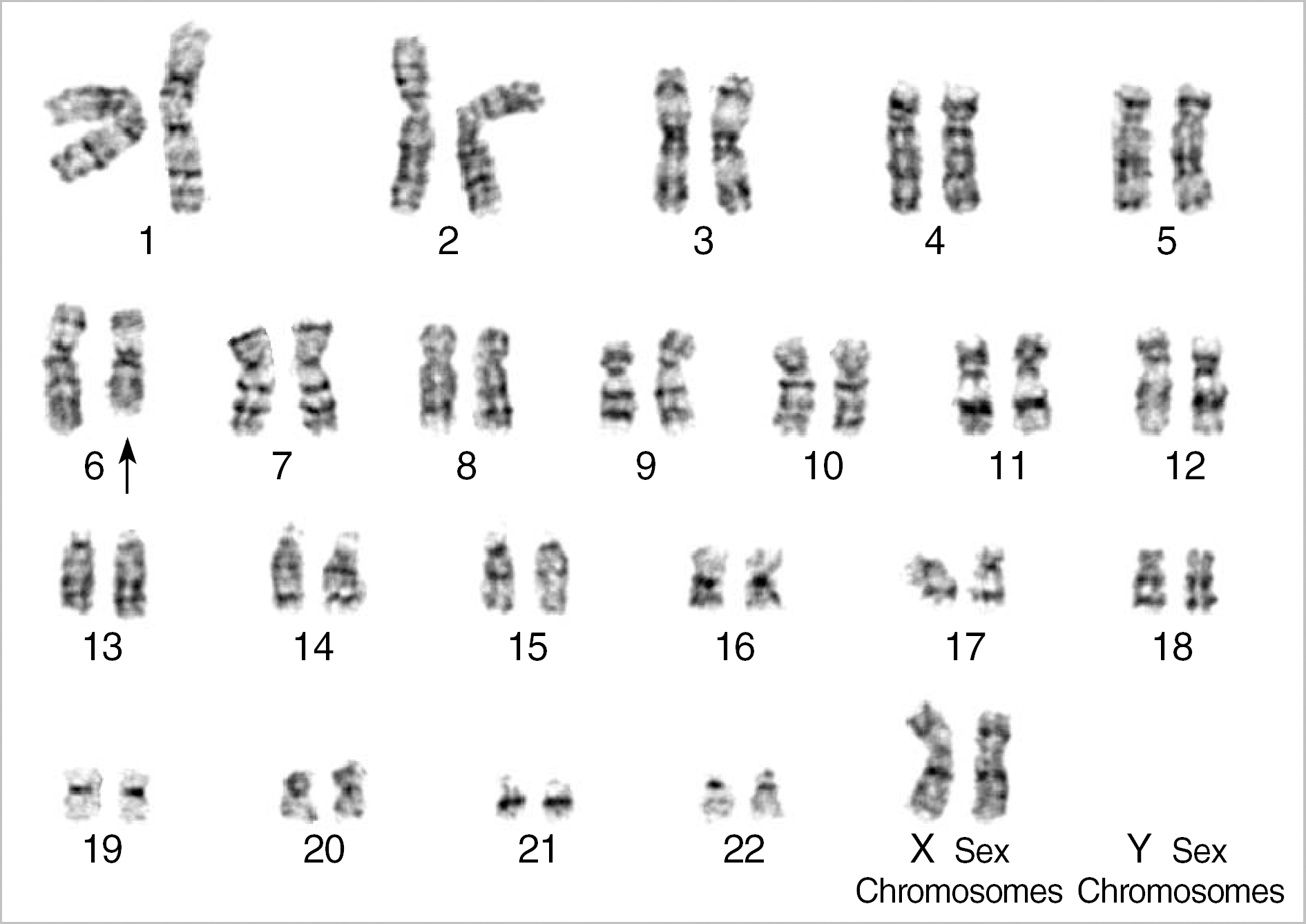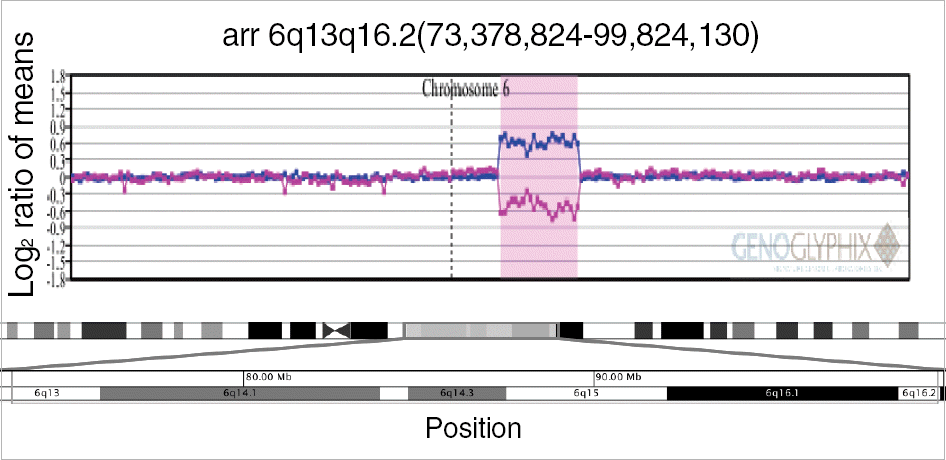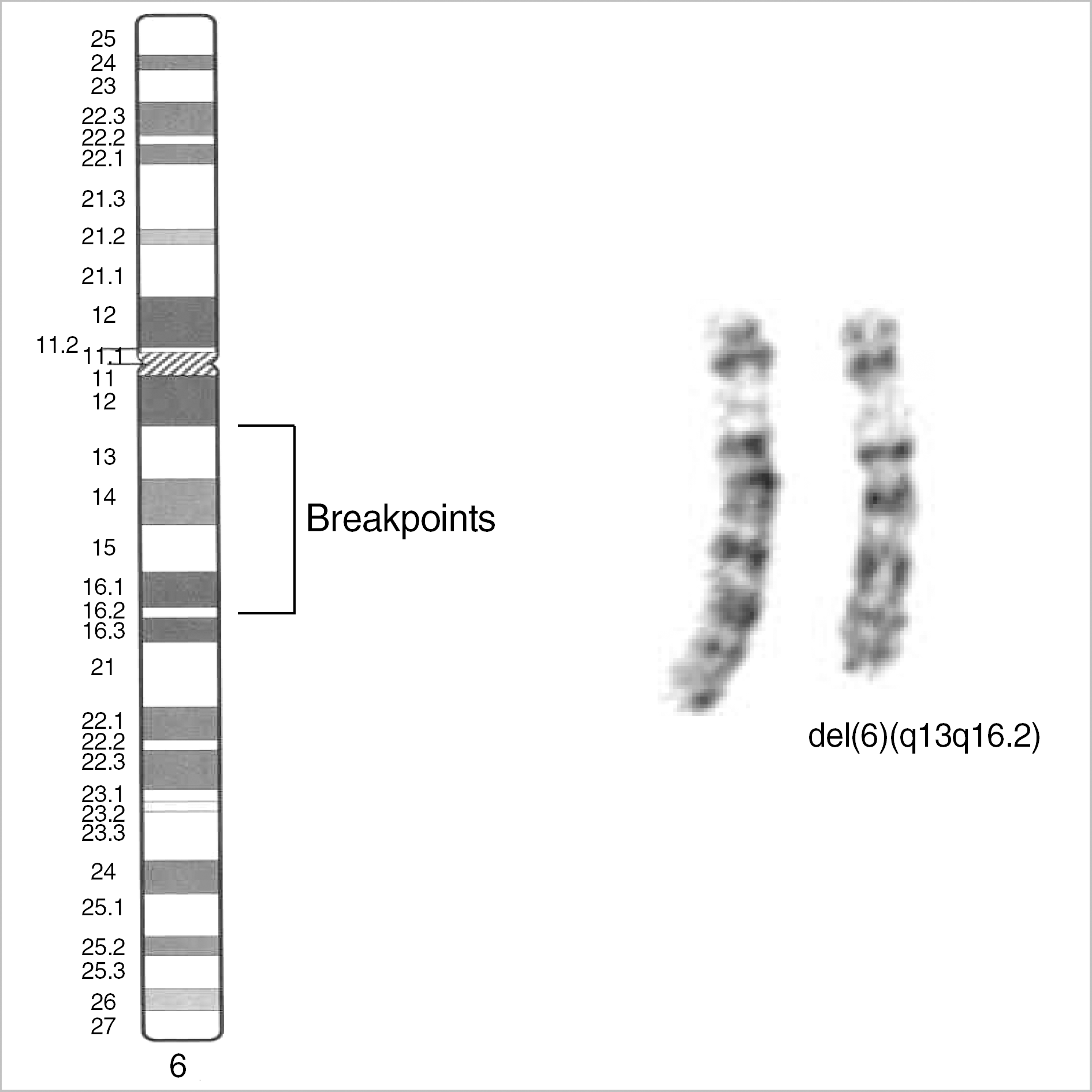Abstract
Deletions of chromosome 6q, particularly in the proximal region, are relatively rare. Here, we report on a de novo interstitial deletion of (6)(q13q16.2) in a girl with facial dysmorphism, congenital hip dislocation, porencephaly, and brain atrophy. Array comparative genomic hybridization analysis showed arr 6q13q16.2(73,378,824-99,824,130), demonstrating higher resolution than the conventional cytogenetic findings, del(6)(q12q15). The clinical data were analyzed and compared with those of similar patients previously reported in the literature.
Go to : 
REFERENCES
1.Chae KY., Nam YH. Deletion of the long arm of chromosome 6 associated with arachnoid cyst and brain atropy. J Korean Child Neurol Soc. 1999. 7:250–6.
2.Hopkin RJ., Schorry E., Bofinger M., Milatovich A., Stern HJ., Jayne C, et al. New insights into the phenotypes of 6q deletions. Am J Med Genet. 1997. 70:377–86.

3.Mikkelsen M., Dyggve H. (6;15) Translocation with loss of chromosome material in the patient and various chromosome aberrations in family members. Hum Genet. 1973. 18:195–202.

4.Klein OD., Cotter PD., Moore MW., Zanko A., Gilats M., Epstein CJ, et al. Interstitial deletions of chromosome 6q: genotype-phenotype correlation utilizing array CGH. Clin Genet. 2007. 71:260–6.

5.Myers SM., Challman TD. Proximal 6q interstitial deletion without severe mental retardation. Genet Couns. 2005. 16:269–76.
6.McNeal RM., Skoglund RR., Francke U. Congenital anomalies including the VATER association in a patient with del(6)q deletion. J Pediatr. 1977. 91:957–60.
7.Young RS., Fidone GS., Reider-Garcia PA., Hansen KL., McCombs JL., Moore CM. Deletions of the long arm of chromosome 6: two new cases and review of the literature. Am J Med Genet. 1985. 20:21–9.

8.Yamamoto Y., Okamoto N., Shiraishi H., Yanagisawa M., Kamoshita S. Deletion of proximal 6q: a clinical report and review of the literature. Am J Med Genet. 1986. 25:467–71.

9.Slater HR., Robb A., Forsyth LA., Hamilton DA., Clark MC., Galloway CA. Interstitial deletion (6) (q11——q15) in an infant with congenital abnormalities. J Med Genet. 1988. 25:210–1.

10.Lonardo F., Colantuoni M., Festa B., Gentile G., Guerritore G., Perone L, et al. A malformed girl with a de novo proximal 6q deletion. Ann Genet. 1988. 31:57–9.
11.Turleau C., Demay G., Cabanis MO., Lenoir G., de Grouchy J. 6q1 monosomy: a distinctive syndrome. Clin Genet. 1988. 34:38–42.

12.Valtat C., Galliano D., Mettey R., Toutain A., Moraine C. Monosomy 6q: report on four new cases. Clin Genet. 1992. 41:159–66.

13.Gershoni-Baruch R., Mandel H., Bar EI H., Bar-Nizan N., Borochowitz Z., Dar H. Interstitial deletion (6)q13q15. Am J Med Genet. 1996. 62:345–7.

14.Romie SS., Hartsfield JK Jr., Sutcliffe MJ., Dumont DP., Kousseff BG. Monosomy 6q1: syndrome delineation. Am J Med Genet. 1996. 62:105–8.

15.Kumar R., Riordan D., Dawson AJ., Chudley AE. Proximal interstitial 6q deletion: a recognizable syndrome. Am J Med Genet. 1997. 71:353–6.

16.Warman ML., Tiller GE., Polumbo PA., Seldin MF., Rochelle JM., Knoll JH, et al. Physical and linkage mapping of the human and murine genes for the alpha 1 chain of type IX collagen (COL9A1). Genomics. 1993. 17:694–8.
17.Zherebtsov MM., Klein RT., Aviv H., Toruner GA., Hanna NN., Brooks SS. Further delineation of interstitial chromosome 6 deletion syndrome and review of the literature. Clin Dysmorphol. 2007. 16:135–40.

18.Gershoni-Baruch R., Mandel H., Bar El H., Bar-Nizan N., Borochowitz Z., Dar H. Interstitial deletion (6)q13q15. Am J Med Genet. 1996. 62:345–7.

19.Duran-Gonzalez J., Gutierrez-Angulo M., Garcia-Cruz D., de la Luz Ayala M., Padilla M., Davalos IP. A de novo interstitial 6q deletion in a boy with a split hand malformation. J Appl Genet. 2007. 48:405–7.
20.Yu M., Obringer AC., Fowler MH., Hummel M., Wenger SL. Prenatal detection of deletion 6q13q15 in a complex karyotype. Prenat Diagn. 2005. 25:1084–7.

21.Schuster M., Lohscheller J., Kummer P., Eysholdt U., Rosanowski F. Severe sensory hearing loss in del(6q)-syndrome. Int J Pediatr Otorhinolaryngol. 2003. 67:1263–6.

22.Le Caignec C., Swillen A., Van Asche E., Fryns JP., Vermeesch JR. Interstitial 6q deletion: clinical and array CGH characterisation of a new patient. Eur J Med Genet. 2005. 48:339–45.

23.Hansson K., Szuhai K., Knijnenburg J., van Haeringen A., de Pater J. Interstitial deletion of 6q without phenotypic effect. Am J Med Genet A. 2007. 143A:1354–7.

Go to : 
 | Fig. 1.The G-banded karyotype of the patient showing an interstitial deletion in the long arm of chromosome 6 (arrow). |
 | Fig. 3.Results of the array CGH analysis of chromosome 6. The pink line represents the patient-to-control fluorescence intensity ratios; the dark blue line represents dye-reversed control-to-patient fluorescence ratios. Microarray analysis showed a single-copy loss of the long arm of chromosome 6 at bands q13 through q16.2, which is 26.4 Mb in size. |
Table 1.
Comparison of clinical findings of proximal 6q deletion previously described in the literature and the patient presented here
| Major findings | McNeal et al., 1977 [6] | Young et al., 1985 [7] | Yamamoto et al., 1986 [8] | Slater et al., 1988 [9] | Lonardo et al., 1988 [10] | Turleau et al., 1988 [11] |
|---|---|---|---|---|---|---|
| Break points | q13 q15 | q13 q15 | q13 q15 | q11 q15 | q13 q15 | q14 q16.2 |
| Facial dysmorphism | +∗ | + | + | + | + | + |
| Brain anomalies | + | + | + | -† | - | + |
| Scoliosis | + | + | + | - | - | - |
| Long slender finger | - | - | - | + | - | - |
| Clinodactyly | + | - | - | - | + | + |
| Single palmar crease | + | + | - | - | + | - |
| Umbilical hernia | + | - | + | + | + | + |
| Inguinal hernia | - | + | - | - | - | - |
| Pes planus | + | - | + | + | - | - |
| Hypotonia | + | + | - | + | - | - |
| Hypermobile joints including dislocated hip | + | + | + | + | + | - |
| Cardiac defect | + | - | + | - | + | - |
| Genital anomalies | - | - | - | + | + | - |
| Renal anomalies | + | - | - | - | - | - |
| Valtat et al., 1992 [12] | Gershoni-Baruch et al., 1996 [13] | Romie et al., 1996 [14] | Kumar et al., 1997 [15] | Presented patient | ||
| Case 1 | Case 2 | |||||
| Break points | q14 q16 | q14 q16 | q13 q15 | q11 q15 | q13 q14.2 | q13q16.2 |
| Facial dysmorphism | + | + | + | + | + | + |
| Brain anomalies | - | - | - | + | + | + |
| Scoliosis | - | - | - | - | + | - |
| Long slender finger | - | - | - | - | + | - |
| Clinodactyly | - | - | - | - | + | - |
| Single palmar crease | - | - | + | - | + | - |
| Umbilical hernia | - | - | + | + | + | + |
| Inguinal hernia | - | - | - | - | - | - |
| Pes planus | - | - | - | - | + | - |
| Hypotonia | - | + | + | + | + | - |
| Hypermobilen joints including dislocated hip | - | - | + | - | + | + |
| Cardiac defect | - | - | - | - | + | - |
| Genital anomalies | - | - | + | - | + | - |
| Renal anomalies | - | - | + | - | - | - |




 PDF
PDF ePub
ePub Citation
Citation Print
Print



 XML Download
XML Download